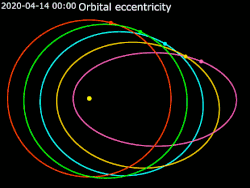Elliptical orbit
In astronomy, an elliptical orbit refers to an object (such as a planet or star) which orbits around a central body in an elliptical motion. This motion follows Kepler's Laws. An elliptical orbit occurs when the eccentricity of its orbit is greater than 0, and less than 1.
The Moon moves around the Earth in an elliptical orbit, and the planets move around the Sun in an elliptical orbit.
Other types of motion in astronomy include circular orbit, parabolic trajectory, and hyperbolic trajectory.
Elliptical Orbit Media
Two bodies with similar mass orbiting around a common barycenter with elliptic orbits.
Two bodies with unequal mass orbiting around a common barycenter with circular orbits.
Two bodies with highly unequal mass orbiting a common barycenter with circular orbits.
An elliptical orbit is depicted in the top-right quadrant of this diagram, where the gravitational potential well of the central mass shows potential energy, and the kinetic energy of the orbital speed is shown in red. The height of the kinetic energy decreases as the orbiting body's speed decreases and distance increases according to Kepler's laws.




